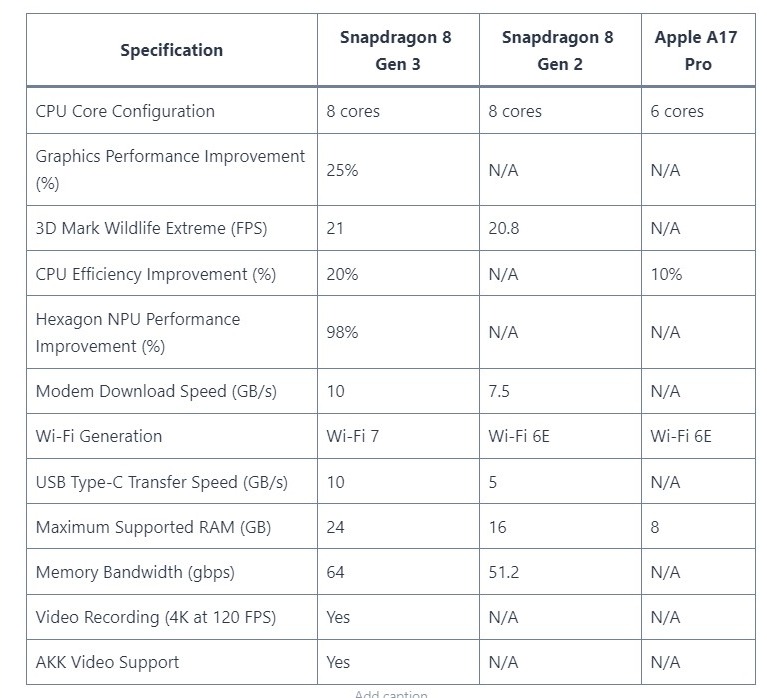The world of mobile technology is constantly evolving, and one of the key battlegrounds is the race to develop the most powerful and efficient mobile processors. Qualcomm, a leading player in this field, has recently unveiled its Snapdragon 8 Gen 3 processor, and the buzz around it suggests that it could be a game-changer. In this article, we will dive deep into the specifications and performance of the Snapdragon 8 Gen 3, compare it to its predecessor and Apple’s A17 Pro, and explore the implications of these advancements in mobile processing.
Snapdragon 8 Gen 3: Unveiling the Beast
Qualcomm’s Snapdragon 8 Gen 3 is generating excitement for several reasons. It promises significant improvements in performance, efficiency, and connectivity, which are all crucial aspects of a modern mobile processor. Below, we provide a breakdown of its key specifications:
CPU Core Configuration
- 8-core CPU
- 1 high-performance core running at 3.3 GHz
- 5 mid-tier cores with a maximum clock speed of 3.15 GHz
- 2 efficiency cores running at 2.27 GHz
GPU Performance
- Graphics performance boost of approximately 25% compared to its predecessor, the Snapdragon 8 Gen 2.
- 3D Mark Wildlife Extreme benchmark results: An average of 21 FPS compared to 20.8 FPS on the A17 Pro.
Efficiency and Power
- The Snapdragon 8 Gen 3 is 25% more power-efficient than the Gen 2.
- CPU efficiency improved by 20%.
- Hexagon NPU (Neural Processing Unit) boasts a 98% performance improvement while being 40% more efficient.
Connectivity
- The Snapdragon X75 modem supports download speeds of up to 10 GB per second, a 25% increase from the previous generation.
- Wi-Fi 7 support, offering numerous improvements in both 2.4 GHz and 5 GHz bands.
- USB Type-C port with 10 GB per second transfer speeds and full DisplayPort support.
Memory
- Supports up to 24 GB of RAM.
- Memory bandwidth increased by 25% to 64 gbps.
Video Capabilities
- 4K video recording at 120 FPS.
- AKK video support for enhanced video quality.
How the Snapdragon 8 Gen 3 Compares
Now that we have a clear picture of the Snapdragon 8 Gen 3’s specifications, it’s time to assess how it stacks up against the competition, particularly Apple’s A17 Pro and its predecessor, the Snapdragon 8 Gen 2. Let’s delve into a comparative analysis:
| Specification | Snapdragon 8 Gen 3 | Snapdragon 8 Gen 2 | Apple A17 Pro |
|---|---|---|---|
| CPU Core Configuration | 8 cores | 8 cores | 6 cores |
| Graphics Performance Improvement (%) | 25% | N/A | N/A |
| 3D Mark Wildlife Extreme (FPS) | 21 | 20.8 | N/A |
| CPU Efficiency Improvement (%) | 20% | N/A | 10% |
| Hexagon NPU Performance Improvement (%) | 98% | N/A | N/A |
| Modem Download Speed (GB/s) | 10 | 7.5 | N/A |
| Wi-Fi Generation | Wi-Fi 7 | Wi-Fi 6E | Wi-Fi 6E |
| USB Type-C Transfer Speed (GB/s) | 10 | 5 | N/A |
| Maximum Supported RAM (GB) | 24 | 16 | 8 |
| Memory Bandwidth (gbps) | 64 | 51.2 | N/A |
| Video Recording (4K at 120 FPS) | Yes | N/A | N/A |
| AKK Video Support | Yes | N/A | N/A |
Note: N/A denotes that specific information was not available for the mentioned processor.
Implications and Considerations
The Snapdragon 8 Gen 3’s impressive specifications indicate that Qualcomm has made significant strides in mobile processor technology. However, it’s essential to consider the broader implications of these advancements:
Competition Heats Up
With the Snapdragon 8 Gen 3, Qualcomm has not only caught up with its predecessor but has potentially exceeded it in various aspects. The processor’s 25% graphics performance improvement is a notable achievement, as it places it on par with or ahead of Apple’s A17 Pro. This competition is excellent news for consumers, as it encourages innovation and pushes manufacturers to deliver more powerful and efficient devices.
Efficiency Matters
Efficiency is a critical factor in mobile processors, as it directly impacts battery life and overall user experience. Qualcomm’s ability to make the Snapdragon 8 Gen 3 25% more power-efficient is a significant accomplishment. In contrast, Apple’s A17 Pro didn’t achieve a similar level of efficiency improvement, potentially impacting real-world battery life.
Multi-Core Approach
Qualcomm’s decision to incorporate eight CPU cores, including five mid-tier cores, is an interesting departure from Apple’s approach, which focuses on fewer high-performance cores. While Apple’s A17 Pro maintains a lead in single-core performance, the Snapdragon 8 Gen 3’s multi-core capabilities could provide advantages in multi-threaded tasks and multitasking scenarios.
Connectivity and Future-Proofing
The Snapdragon X75 modem’s support for 10 GB per second download speeds and Wi-Fi 7 indicates Qualcomm’s commitment to advancing connectivity. These capabilities ensure that Snapdragon 8 Gen 3-powered devices will be well-prepared for future network technologies and evolving connectivity standards.
Real-World Impact
While benchmark scores and technical specifications provide valuable insights, real-world performance and user experiences are equally crucial. Several factors can influence a device’s overall performance, including software optimization, thermal management, and hardware integration. Therefore, it’s essential to consider these aspects when evaluating the Snapdragon 8 Gen 3’s impact on upcoming smartphones.
Conclusion
The Snapdragon 8 Gen 3 is poised to be a formidable contender in the world of mobile processors. Its impressive specifications, including enhanced graphics performance, improved efficiency, and advanced connectivity, position it as a significant player in the market. Qualcomm’s ability to compete head-to-head with Apple’s A17 Pro and potentially outperform it in certain aspects signals a healthy competition that benefits consumers.
As we eagerly await the arrival of smartphones equipped with the Snapdragon 8 Gen 3, it’s crucial to keep an eye on real-world performance and user feedback. Ultimately, the success of this new processor will be determined by its ability to deliver exceptional experiences in the hands of consumers. Whether you’re a loyal Android user or an iPhone enthusiast, the advancements in mobile processor technology are pushing the boundaries of what our smartphones can achieve.













